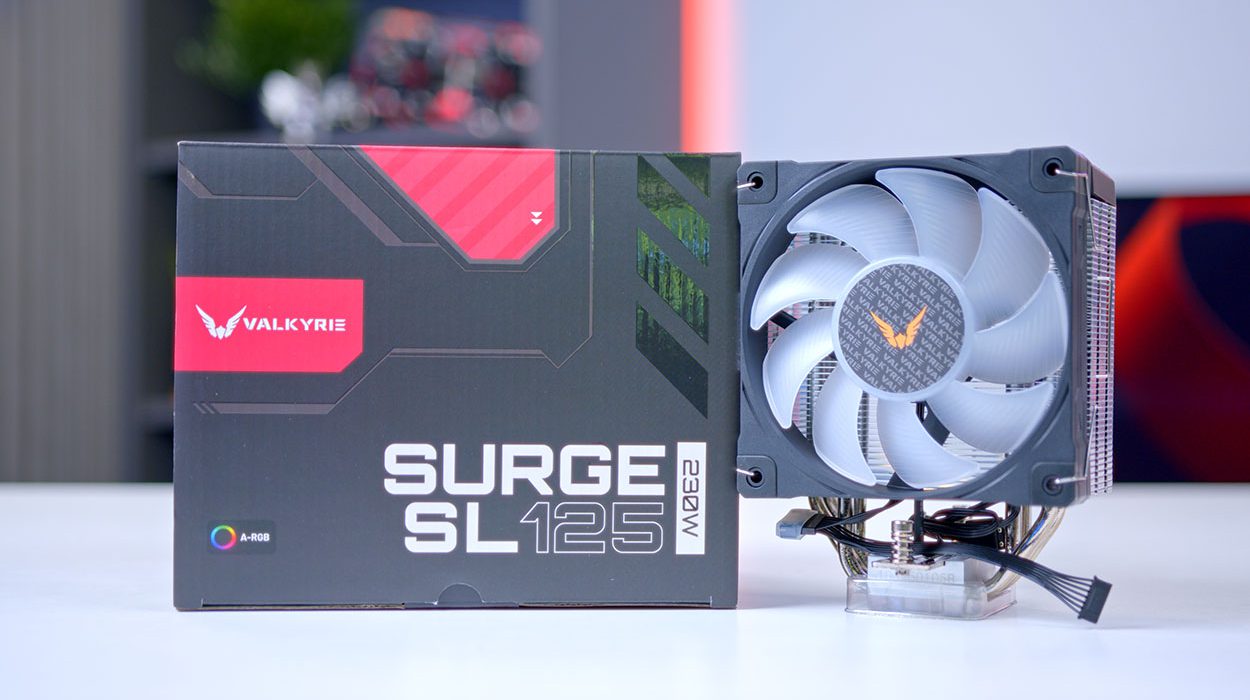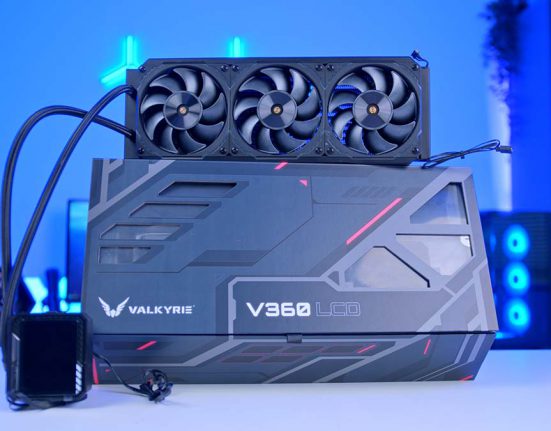The SURGE SL125 CPU air cooler is one of two options from Valkyrie’s range of tower air coolers. This model comes in at an exceptionally low price point set to compete with some budget titans like the Vetroo V5, Thermalright Assassin, and DeepCool AK400. While the SURGE SL125 looks modest at first glance, a true test of its capabilities can be done with some thermal performance benchmarks, which is precisely what we’re doing in this review.
Valkyrie has joined a fairly competitive space, with manufacturers like Thermalright, be quiet!, Noctua and more tying up the air cooler market with their various affordable and more premium offerings for those with a bit more cash. However, suppose the SURGE SL125 can outperform some of the more popular air cooler options while maintaining a low MSRP. In that case, it may very well become the next budget king, for those who are really looking to maximise performance versus pricing.
In this review of the Valkyrie SURGE SL125, we’ll examine its specs, design, installation process, and thermals to determine whether it’s a worthwhile option among the wide array of budget CPU air coolers on the market.
Specification
The Valkyrie SURGE SL125 is a single-fan tower air cooler with a large heatsink stack designed to keep your CPU nice and cool during various workloads. Regarding size, the SURGE SL125 is 157mm tall, which is a standard height for the majority of CPU air coolers. The heatsink stack comprises 48 aluminium fins designed to effectively dissipate heat and shift it away from the CPU out of the heatpipe ends at the top of the cooler.
This air cooler comes with one 120mm Valkyrie B12 A-RGB fan, which is controlled by the universal 4-pin PWM standard, while RGB uses the 3-pin header for addressability. Valkyrie’s B12 A-RGB fans are relatively premium. They use Fluid Dynamic bearings geared for smooth and quiet operation under load. Examples from other manufacturers include be quiet! Silent Wings 4 fans or Corsair AF120 fans. The Valkyrie fans can reach a maximum of 2150RPM, which is standard for a fan of this calibre.

For socket compatibility, Valkyrie has included the most recent 2025 sockets, Intel LGA1851 and AM5, but they’ve also decided to include AM4 and some of the older Intel standards, going all the way back to LGA1151, which is ten years old.
| Key Specs | Valkyrie SURGE SL125 |
|---|---|
| Cooler Height | 157mm |
| Number of Fans | 1 |
| Bearing Type | Fluid Dynamic |
| Fan Connector | PWM |
| Max Fan Speed | 2150RPM |
| Socket Compatibility | Intel – LGA 1851, 1700, 1200, 1151 AMD – AM5, AM4 |
Lastly, there is pricing. The Valkyrie SURGE SL125 is available at the time of writing for 26.58 Euros, which roughly converts to about £22 in the UK or $29 in the US. I think the price of this cooler is incredibly fair. Even if the performance doesn’t quite beat out some of the alternatives, they’ll definitely be competing when it comes to pricing.
Valkyrie SURGE SL125 Design
As you can expect based on the price, the design of the SURGE SL125 isn’t particularly exciting or flashy. Valkyrie are clearly going for function over form, and if the performance is any good, then a lot of prospective buyers aren’t going to care about how the cooler looks.

The heatsink stack is a very typical shiny silver because it is aluminium. Valkyrie could have painted these, but I imagine this wasn’t done to save on costs. Aesthetically, I prefer an all black heatsink, and to some it looks like something out of 2015. I don’t think it’ll massively affect the look of a complete build, but it may steer you more towards a lighter theme to match the silver from the fins.
On top of the heatsink stack is a small textured plastic cap with the text ‘Valkyrie’. This provides a pleasant aesthetic change to the rather bright heatsink stack, but it also covers the heatpipe ends that poke out of the top of the heatsink and will help to darken the side profile of any gaming PC build in which you install this cooler.

The B12 A-RGB fan looks and feels familiar. It resembles a DeepCool fan style, with rubberised corners and a more square shape. These fans easily clip onto the side of the heatsink. There does look to be space for an additional fan on the other side, but Valkyrie doesn’t supply one in the box.

Otherwise, there’s not much else to discuss from a design perspective. The B12 fan uses addressable RGB, which can be plugged into a supporting motherboard header to add extra customisation. Because it uses addressable 3-pin RGB instead of proprietary cabling, it’s also incredibly easy to plug it into other supporting components.
To summarise this section, I think the design is fine. It’s not going to blow you away. It’s nice that the Valkyrie air cooler offers RGB compatibility, as it adds a splash of colour to what would be an otherwise very boring-looking cooler.
Valkyrie SURGE SL125 Performance
Cinebench 4-Thread
Our first benchmark to test the SURGE SL125 was a Cinebench 4-Thread run. Four threads are typically used in most games, as gaming only requires a few cores at the maximum. Therefore, this is the kind of performance you can expect while gaming. In this four-thread benchmark, the SURGE SL125 averaged 72°C with a maximum of 77°C. This places it below the DeepCool AG400 at 70°C, and five degrees below the AK620.

We’re not shocked by the performance here, but it’s fairly clear from the results that the single-fan coolers are not as competent in this benchmark. While 72°C isn’t dangerous by any means, it is quite toasty for just gaming. However, it’s worth noting that we tested this air cooler with an Intel Core i7-14700K, so a CPU like the Ryzen 5 7600 would likely run much cooler on average.
Cinebench 8-Thread
In the eight-thread run of the same benchmark, the Valkyrie SURGE SL125 ‘surged’ up the leaderboard, sitting just below the DeepCool AK620 Digital at 83°C. We did a couple of retests to confirm if this result was an anomaly, but the retests confirmed that the SURGE SL125 can handle more challenging multi-core workloads reasonably well.

CPU-Z 8-Thread
Our last benchmark was CPU-Z, in which we ran an eight-thread test. Bar the AK620 Digital, the SURGE SL125 is at the top of the air coolers with an 83°C average and a maximum of 85°C. CPU-Z tests for throttling and stability, so the variance between the average and maximum is small. There’s a fair amount of separation between air and liquid coolers, with the LS520 sitting at 78°C.

Overall, I’d say the SURGE SL125’s performance is fairly strong. It can compete with other strong air coolers that we’ve tested in the past and holds up well in some of the more challenging multi-core benchmarks.
Is Air Cooling Worth it in 2025?
Air coolers used to be the go-to for many because they were considerably cheaper than liquid coolers. Closed-loop AIOs (all-in-one) are much more affordable than they used to be, easier to install, and almost a requirement for some mid-range and top-end CPUs you can buy.

But does that mean air cooling is on its way out? In short, no. While a liquid cooler would be my go-to recommendation for most builders, air coolers are highly affordable and generally supported in most cases. Whereas a 360mm liquid cooler might not fit in your case of choice. Air cooling is an excellent option for those with limited space or restricted to a relatively tight budget. CPU coolers like the SURGE SL125, Cooler Master’s Hyper 212 series, or Thermalright’s Peerless Assassin are a solid alternative if you’re not worried about adhering to a particular aesthetic and need a cheap but powerful cooling solution.

However, there are limitations. The most obvious one, as we can see from the data above, is that multi-core workloads are a struggle. While most air coolers can handle your run-of-the-mill gaming PC, they generally struggle with challenging workloads that use more than 3 or 4 cores. Additionally, you’ll be limited in terms of your CPU choice. While we’ve established that the SURGE SL125 can handle a Core i7-14700K, this isn’t a cooler I’d recommend pairing it with. Air coolers are generally geared towards budget and mid-range processors that don’t output ridiculous power and heat.
So, is air cooling worth it in 2025? It can be, but only if you’re aware of the advantages and limitations. Pros: It’s cheaper compared to most liquid coolers and great for those on a budget. However, you will be limited to a particular set of CPUs and will likely find that the performance is better than that of most radiators.
Conclusion
Valkyrie SURGE SL125

Product Name: SURGE SL125
Brand: Valkyrie
-
Features
-
Design
-
Performance
-
Value For Money
Summary
The Valkyrie SURGE SL125 is an impressive air cooler. I was initially skeptical of the SURGE SL125, as it’s joining an already overcrowded and highly competitive market. Air cooling is often a tough area to compete in because the existing manufacturers that offer products in this space pretty much have it locked down. However, Valkyrie may be able to penetrate this market with the SURGE SL125. This cooler is one of the strongest air coolers that we’ve tested, despite the fact that it only has one fan. It’s also super simple to install and highly affordable. These three qualities make the SURGE SL125 an excellent competitor, potentially dethroning the likes of Thermalright, DeepCool, and be quiet!.
My only qualm with this cooler is that availability, at present, is poor compared to other retailers. While I could argue that the design and lack of features make this cooler a weak option, I really don’t think they do. This is, for all intensive purposes, a budget cooler. It’s less than $30, which means the kind of prospective buyers are going to be builders that need a solid but cheap option. For this reason, we can understand that the intention of this cooler isn’t to have a mindblowing design. With all this in mind, I think the Valkyrie SURGE SL125 is a solid all-round budget air cooler, and I hope that Valkyrie can get this product out there a bit more so it’s available for more builders.
Pros
✅ Highly affordable
✅ Easy to install
✅ Solid performance
Cons
❌ Fairly plain aesthetic
❌ Essentially no additional features
❌ Scarce availability




